In the United States in 2014, an estimated 221,000 people, age 65 and older, were injured in motor vehicle accidents and 5,709 were killed. These elderly people comprised 17% of the total traffic-related fatalities that year and 9% of traffic-related injuries. A year later, 4,366 people, age 70 and older, were killed in motor vehicle accidents, which is a 16% increase since 1975.

Older drivers may not be the majority of people in vehicles who are killed or injured in crashes, and that may be due to their relative driving population compared to the rest of drivers. Regardless, their unique driving needs must be addressed to prevent further increases in traffic-related injuries. It is certainly difficult to admit to oneself, but the process of aging can reduce awareness and other cognitive functions that are necessary to drive safely.
Age-related decline in vision, the ability to reason, and the ability to remember can all contribute to vehicle crashes involving elderly folks. Hence, we must consider how to help seniors enjoy continued freedom while helping them drive safely. Sometimes, an older person’s age doesn’t make them more dangerous on the road to others; rather, it makes them more susceptible to injury or death due to fragility.
In an effort to balance an elderly person’s desire for freedom with the safety of the public, it helps to analyze as many facts and figures as we can regarding older drivers and motor vehicle accidents. Here are some of the numbers to consider.
In 2014, statistics offered the following information:
In 2015, nation-wide statistics offered the following information:
Interestingly, in motor vehicle crashes where at least one driver was age 30 or younger, 39% of deaths were the drivers, 20% were their passengers, and 40% were occupants of other vehicles, pedestrians, or motorcyclists.
In Louisiana in 2014, older drivers (age 65 and older) involved in fatal traffic crashes comprised 9.6% of the total driver involvement. In 2015, older drivers accounted for 10.9% of total driver involvement in fatal traffic accidents. The percentages that may seem low to some can be attributed to several factors, including fewer older drivers on the road and fewer miles traveled by older drivers. But, even though percentages are lower for older drivers than other ages of drivers, there’s still concern about the ability for these drivers to operate a vehicle safety.
Seniors face stricter renewal processes to ensure their ability to drive doesn’t become impaired.
In Louisiana, special rules apply to drivers who are 70 years and older and wish to continue operating a motor vehicle. For example:
Renewals for elderly drivers take place in person every four years. A vision test is required at all in-person renewals; in some cases, the exam may be taken at an outside ophthalmologist or optometrist, within 30 days of the renewal request.
Other requirements may include a written test or road test, which is determined by the OMV if there are indications of driver impairment.
Depending on the driver, the OMV may place specific restrictions on an elderly person’s license. Common restrictions include the following:
These restrictions should not incite prejudice toward elderly drivers but are precautionary measures to ensure safe drivers are able to maintain their independence on the road.
Just as we would want to reduce risk in young drivers and middle-aged drivers, we should research ways elderly drivers specifically might stay safer on the roads. Like any other population of vehicle operators, these older drivers can potentially avoid injury and death, to themselves and to others, by
The Louisianan OMV is obligated to accept information from any familiar source with regard to an elderly driver that may be incapable of properly operating a motor vehicle. To request an unsafe driver investigation in Louisiana, you must first complete a Report of Driver Condition or Behavior. Doctors or family physicians can also aid a case by completing a Medical Examination Form.
Everyone has a responsibility to ensure senior drivers are complying with the rules and regulations of the road. While most seniors prefer their independence, driving is not a right; it is a privilege.
If you have an elderly family member that drives regularly, it’s wise to monitor their driving behavior frequently to ensure they’re not putting themselves or others at risk. Elderly drivers may unintentionally cause injury to someone else, or suffer a car accident.
If you have questions about a car accident or injury caused by an elderly driver in Louisianan, we at the Monroe Law Office of J. Antonio Tramontana, Attorney at Law, want to hear from you.
Drivers all over the state of Louisiana are facing high costs when it comes to operating their vehicles, and poor road conditions might be the most harrowing. A recent article in The Greater Baton Rouge Business Report stated how bad the road conditions actually are in Baton Rouge, and there’s evidence of major road troubles in other cities too, including Lafayette.
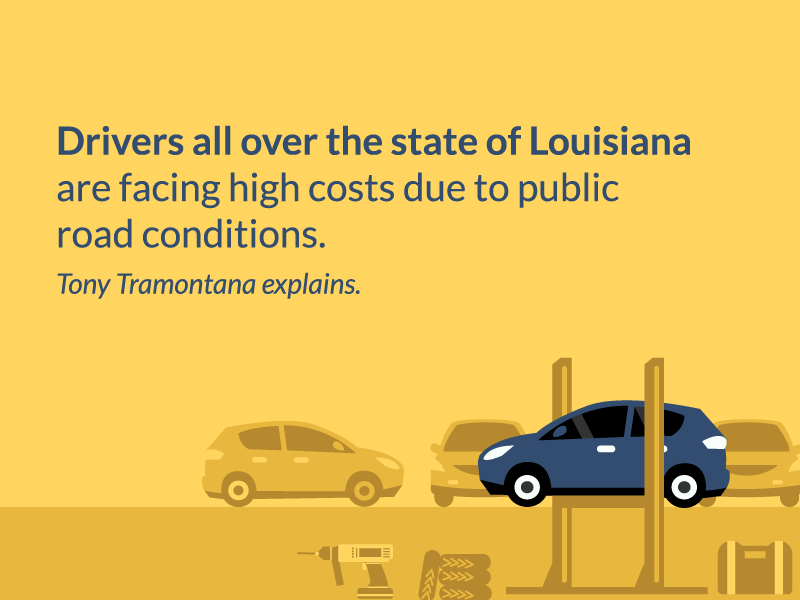
It’s hard enough to deal with the exorbitant costs of fuel and general vehicular maintenance. Add to the mix shoddy road conditions and the damages they cause, and drivers in our state face a dire situation.
The Greater Baton Rouge Business Report revealed that the annual cost for a Baton Rouge resident to drive a car on the city’s roads is $2,466.
This cost is the highest in our state, factoring in only the price of driving on Louisiana roads as related to often-poor street and highway conditions, lack of safety features in our infrastructure, and general costs to operate a car.
If our state’s roads are so bad, riddled with potholes and shoulders that simply drop off, what do you think the chances of getting into a car accident are? Pretty high, right? Additionally, Louisiana drivers frequently have to deal with construction zones blocked off in order to repair roads, which is yet another hazard for which drivers are sometimes left to pay the price.
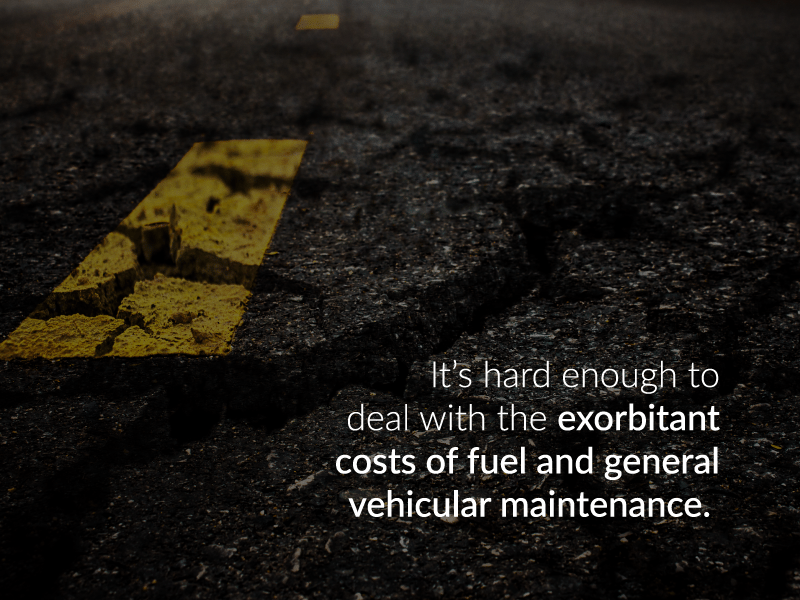
Along with the high costs of repairing a car that’s been wrecked due to poor infrastructure, people are injured in these accidents. Injuries that happen because someone in government failed to maintain a road shouldn’t happen. So, who’s at fault if it does?
In many cases, the government entity (a city, county or state) is liable for the auto accident if a poor road caused the crash. These organizations are charged with maintaining public roads for public safety. If they don’t do their job, they can be held accountable.
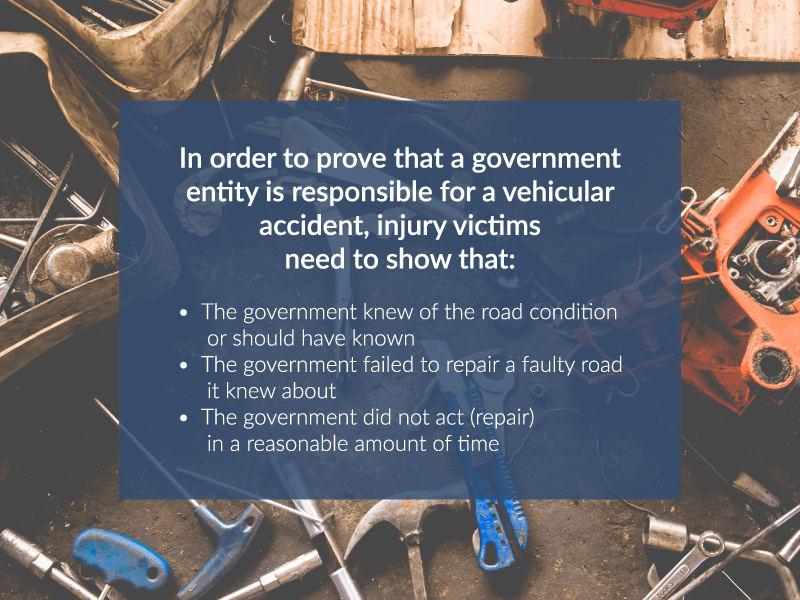
In order to prove that a government entity is responsible for a vehicular accident, injury victims need to show that:
If you’ve been in an accident and you think a poor road in our state was the cause, you might be wise to make a claim for damages. The first thing you should do after your accident is to seek medical attention if required. Then, document the following:
When making a claim, you will need to know which government entity is responsible for the section of road related to your accident. You can call the county commissioner’s office for help locating the government entity to which you will direct your claim.
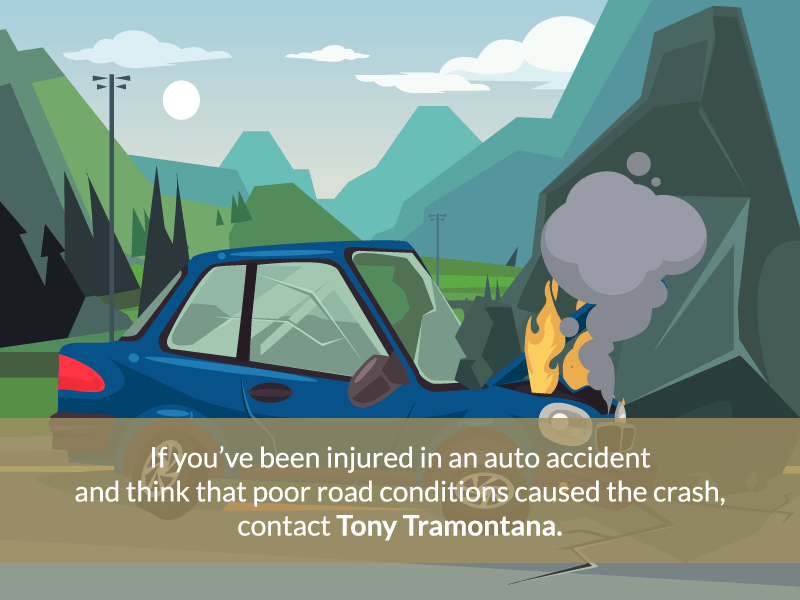
If you’ve been injured in an auto accident and think that poor road conditions caused the crash, contact Tony Tramontana. We want to hear your story and help you with your claim. Fill out the form on the bottom of this page and we will be in touch with you promptly.
If you find yourself in a future fender bender in New Orleans, don’t be surprised if a civilian is the one investigating it. The city recently green-lighted a plan for common folk and possibly retired police officers, under the management of a New-Orleans based “civil traffic accident investigation and support” firm, to be given contracts to review traffic accidents.
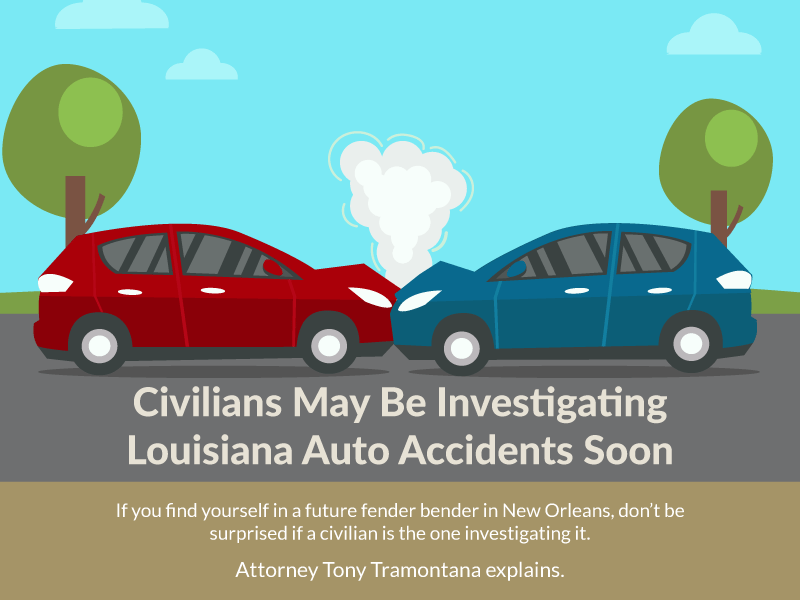
As of September 12, 2017, a proposal written to provide support in the collection of information on non-DWI and non-injury accidents effectively took the investigative role out of the hands of the New Orleans Police Department. The move was an effort to free up time for officers in the department. The contractors will gather evidence and then send data over to police, which will allow officers to put more of their time and resources into non-traffic duties.
The New Orleans Police Department has specific requirements that had to be met in order for the requested proposals to be considered. Each proposal for traffic investigative contract work had to include a commitment to:
The City of New Orleans’ request for proposals ultimately gives police discretion when deciding how they will use civilian investigators and to what extent. The police department can choose which geographical areas the civilian investigations will take place in and to which types of accidents they will be sent. Police will also be allowed to train investigators in whatever manner suits the department’s purposes.
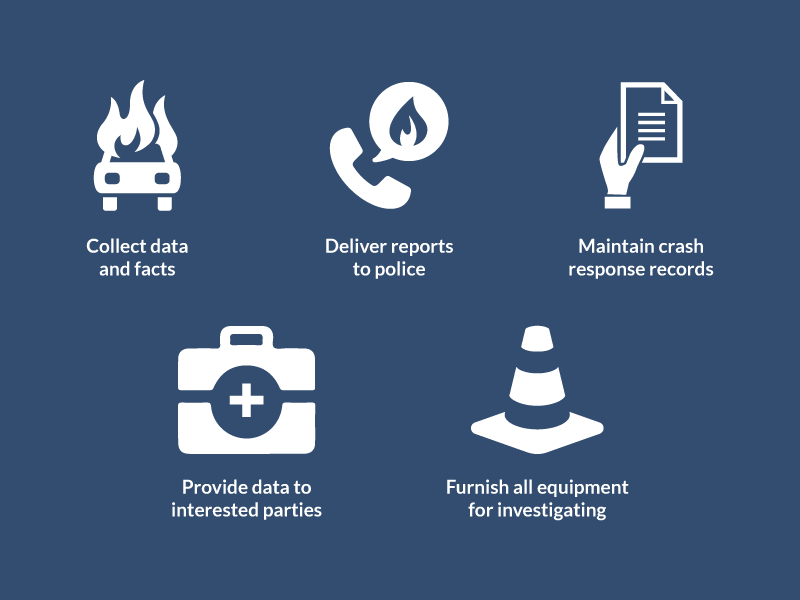
This year’s legislative session saw Sen. Wesley Bishop (D-New Orleans) draft a bill that would have allowed the city to use civilian investigators. But, it didn’t make it out of committee. Even though the idea failed in the legislature, a spokesperson for Mayor Mitch Landrieu’s administration, Erin Burns, says that city officials are sure that their plan complies with Louisiana law. Burns confirmed that the initiative already received a “go-ahead” from New Orleans’ city attorney.
Burns adds that she believes the legislature would have eventually solidified the plan and that it is indeed legal. She suggests that civilian investigation of certain traffic accidents is a helpful way for New Orleans to move forward in increasing manpower for the police department and on the city streets.
After the city and New Orleans Police Department met at City Hall in September, they decided that On Scene Services would win the proposal war over two other companies vying for the contract; city officials voted to begin contract negotiations. The winning proposal includes On Scene Services hiring Pinnacle Security and Investigations, Inc. to hire the necessary traffic officers – a plan of action that would not require an upfront cost to the city. All costs would be paid for by ordered services including accident reports, video footage, and witness statements, in tiered or custom packages ranging from $100 to $600.
On-Scene Services will hire reserve, off-duty, or retired police officers to fulfill investigative duties. The firm says it has run a similar model at times, and it feels confident it can provide the service to New Orleans at no cost to the city.
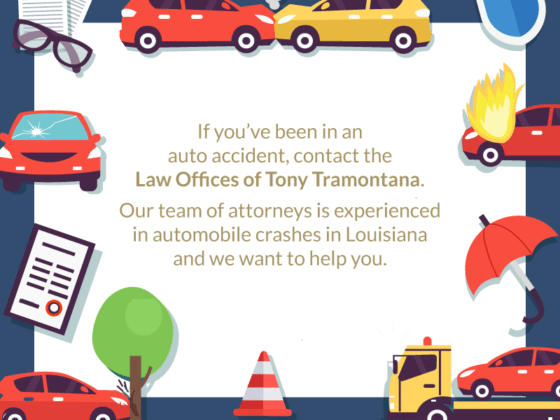
Fender benders take up too many man hours and resources, according to the New Orleans Police Department. Now, with the green-light of the plan, the city can focus efforts elsewhere. What will this mean for citizens who get into minor accidents? Maybe not much that’s noteworthy.
Regardless of who is investigating an accident, those involved should still document all of the details of the accident themselves and then call an attorney – whether there were immediate injuries or not.
If you’ve been in an auto accident, contact the Law Offices of Tony Tramontana today.
According to the Centers for Disease Control and Prevention (CDC), motor vehicle crashes are a leading cause of death for a child passenger in the United States.
Child safety seats are required in every state because they’re proven to maximize safety for a child passenger in the event of a car accident. Using a car seat reduced the risk of death to infants by 71% and to toddlers by 54%. Sadly, child restraint systems are often used incorrectly, or sometimes, not at all.
There’s a reason car manufacturers are required to display warning labels regarding airbags because the airbag deployment zone is extremely dangerous for young passengers. Airbags deploy with tremendous force and speed, which can cause serious injury or death to a child.
This is why it’s recommended that most children, 13 years or younger, sit properly restrained in the back seat of a vehicle.
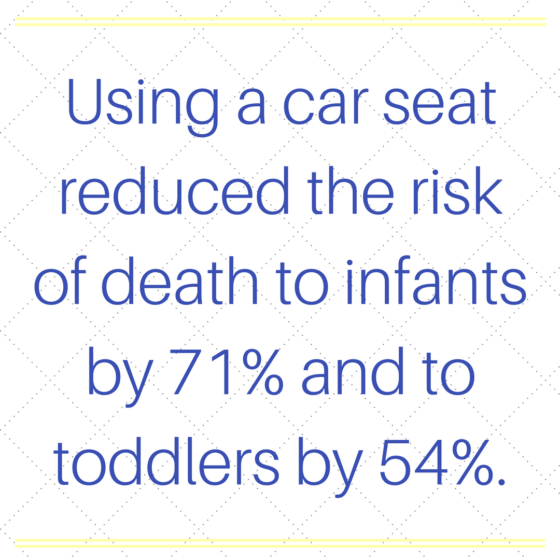
Age and size-appropriate child restraint use is the most effective method for reducing injury and death among child passengers.
The Louisiana Highway Safety Commission (LHSC) regulates our state’s child passenger safety laws. More specifically, Louisiana state law requires:
Child car seat laws are not suggestions. Violations of the child restraint laws are standard offenses. Drivers with child passengers can be ticketed and fined for breaking child safety laws; in Louisiana, fine amounts increase with subsequent violations.
Fortunately, Louisiana offers extensive help for drivers in need of assistance with their child safety seats and restraints. There are numerous technicians available to provide education and installation assistance should it be necessary.
While all states have child safety seat laws, these laws are not the same state-to-state. This is also the case with mandatory safety belt laws; some states have secondary enforcement of such laws, which means a driver can’t be pulled over simply for not wearing his seat belt; and some state laws don’t cover passengers sitting in the back seat.
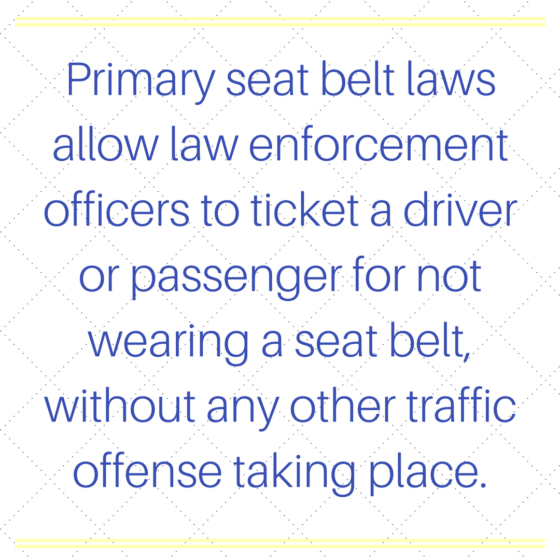
For example, New Hampshire is the only state without a mandatory safety belt law. Arizona, Nevada, Idaho, and Montana, among others, have secondary enforcement laws.
Louisiana, California, Texas, and Florida, to name a few, utilize primary enforcement, meaning the driver may be cited solely for belt law violations, and the law covers all passengers in a vehicle.
According to the CDC, restraint use among children often depends on the driver’s seat belt use. Almost 40% of children riding with unbelted drivers were themselves unrestrained.
In other words, children who see their driver buckle up are more likely to do so as a passenger.
The CDC also notes other disparities in seat belt use among children: black and Hispanic children are more likely to not be buckled up compared to other groups; older children (8-12 years old) are more likely to be unbuckled compared to younger children (4-7 years old).
See the IIHS page below for state details regarding enforcement of safety belt laws and at what age a child must be in a child restraint or booster seat:
Thousands of people die every year because they don’t buckle up. Children watch our behavior behind the wheel, so it stands to reason that despite the particulars of your state’s enforcement, buckling up is a good way to instill these important safety precautions in a child passenger, who will eventually become a teen driver.
The CDC, in combination with state agencies and other organizations like the Insurance Institute for Highway Safety (IIHS), are developing strategies to increase seat belt and child restraint use in Louisiana, and across the board.
This includes adopting primary seat belt laws in all states, incentive and education programs for parents, and seat belt checkpoints, to name but a few.
Child passenger safety is everyone’s responsibility. If you have any questions about an auto accident or injury caused by a negligent driver or defective child restraint, we at the Monroe Law Office of J. Antonio Tramontana want to hear from you.
For a free case review, please fill out the form to the right, or call us directly at (888) 982-1290.
If you were injured in an auto accident in Louisiana, your personal injury case is subject to a different set of rules than had you been in another state. Louisiana is a direct action state, which means parties injured in a car accident can name an insurance carrier in a lawsuit. This is not something that’s allowed in other states. Here we explain Louisiana accident laws and how they may affect your case.

Because Louisiana is a direct action state, an injured party can name an insurance carrier directly in a court case. This helps the injured party because a judge overseeing the case will know that there is an insurance company available to cover any damages. Usually, judges and juries will award more damages if an insurance company is named to pay the claim, instead of the individual who caused the accident.
Often, juries are sympathetic to drivers who cause accidents, if there isn’t an insurance carrier named in the lawsuit. This is because the jury perceives that the negligent driver will need to come up with all of the damages out of pocket, which can be difficult or impossible to do.
Juries sometimes feel hesitant to penalize drivers and hold them responsible for huge judgments. For example, if a driver for a small mom-and-pop company caused an accident, an award against the little company could devastate it. The same holds true for an individual or person with a family.
Many cases are tried in which the defending attorney appeals to the jury to use compassion when awarding damages. Best practices for a plaintiff’s attorney, then, is to always name the insurance carrier in a lawsuit. This makes it clear to the jury that the defendant is not being asked to pay any of the award.
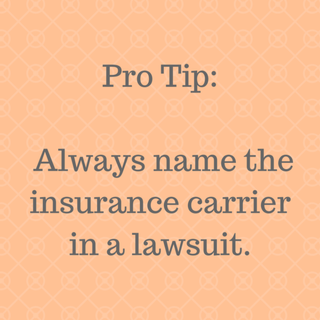
Another difference in Louisiana accident laws than other states is that Louisiana has a one-year statute of limitations. There aren’t any kinds of pre-lawsuit requirements in terms of claim processes, so the injured party is expected to file a suit any time from one day after the accident until exactly one year after.
If too much time passes after a crime occurs, the Louisiana Statues of Limitations will prevent you from pursuing restituttion for loss or damage.
Because Louisiana is a comparative negligence state, an injured party who is at fault for an accident can have damages reduced by the determined percentage of fault.
Louisiana’s required insurance minimum amounts are very low compared to other states. As an example, the state has a $15,000 bodily injury minimum for driver insurance policies. There are unfortunately many cases that go through litigation where the negligent party only has the minimum coverage. This effectively limits the injured party’s recovery of damages to just $15,000.
If you’ve been involved in an auto accident in the state of Louisiana, there are many elements to consider should you want to file a personal injury lawsuit. Tramontana Law has years of experience trying auto injury cases in the state of Louisiana. We know how to work within the various areas of the law to properly try your case so that you get the maximum amount of damages awarded to cover your medical expenses and other losses.
Fill out the form on this page and an attorney from the Law Office of Tony Tramontana will be in touch with you shortly. We want to hear your story and help get the justice you deserve.
From 2014 to 2016, more than 90 people were involved in fatal accidents in Tangipahoa Parish. That statistic, according to a campaigner working to reduce the number of avoidable deaths, is too many, and indicates that change is needed in Louisianans’ driving habits.
Donna Miller, Tangipahoa Parish President Robby Miller’s wife, is a local businesswoman who approached former state police trooper Ron Whittaker regarding the unfortunate number of fatal vehicle crashes. She was particularly concerned with the number of tragedies involving young victims, who are grossly over-represented in car crashes that lead to death.
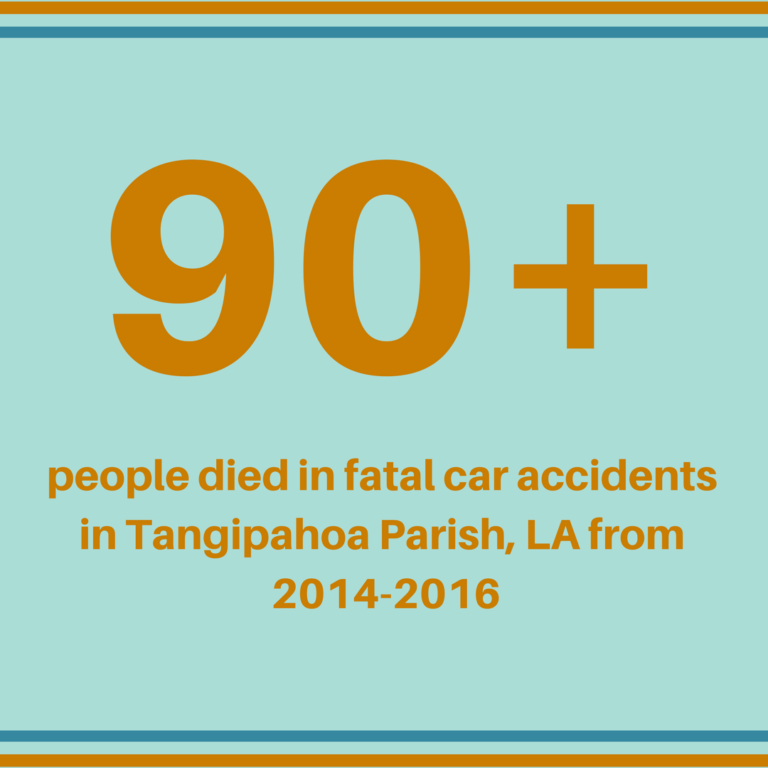
Whittaker lives in Hammond and he spoke to the Hammond Kiwanis Club recently about Miller’s concerns. He addressed the Stop the Knock campaign, a large campaign in neighboring Mississippi, which would hopefully stop that knock on the door when police officers have to tell a family their loved one has died in an accident.
Miller sought out Whittaker’s assistance in her campaign after hearing of 3 Louisiana residents who died in car crashes, in just a 10-day period. All of the accidents during this short time had alarming similarities. They involved youth driving on 2-lane narrow roads, the drivers were speeding, and 2 of the 3 victims weren’t wearing seatbelts.
“We’ve got to stop that knock,” Whittaker told the attendees of the Kiwanis meeting. Miller was supposed to join Whittaker at the presentation, but she couldn’t, ironically. She was at a funeral for former NFL player and Mayor of the Village of Tangipahoa, Michael Dywane Jackson Dyson, who was killed a few days earlier in a fatal vehicle accident.
Two residents of Hammond died earlier that week, in separate accidents; the victims were just 18 and 32 years old. Miller’s campaign hopes to put an end to these types of fatal accidents that result in lives taken way too early.
Stop the Knock involves talking to civic groups and leaders about the top causes of fatal car crashes. It attempts to educate those with the power to pass laws and influence others, teaching them how to help reduce fatalities by an auto accident.
Whittaker’s talk with the Kiwanis club urged leaders of the group to encourage young people to drive defensively, to avoid distractions, and to always wear a seatbelt. She also hoped to reinforce how important it is to never drive impaired. Tangipahoa Parish has several ways for drinkers to get a ride home, including Your Ride, Our Driver, LLC., a company started by off-duty police officers that provides professionally-driven rides through a booked service.
Texting, talking, and eating while driving are all forms of distracted driving—one of the leading causes of fatal accidents. Whittaker says that young people who have more than 3 other youths in the car quadruple the odds of getting into a car crash.
What else makes for a dangerous driving situation?
If you’ve been the victim of someone who has not driven responsibly and who has caused you injury from a car accident, my team of attorneys at The Law Offices of Tony Tramontana would like to talk with you. Fill out the contact form on this page and we’ll be in touch.
A recent study has identified US 90 running through South Louisiana as the most dangerous highway in the entire state, also reportedly the 13th most dangerous highway in the country.
In the study, which business fleet and transportation consulting firm Geotab released to the public, data compiled by the Federal Highway Administration and National Highway Traffic Safety Administration was combed through to reveal the most dangerous highways. All highways considered were given a “Fatal Crash Rate” as determined by examining the number of deadly crashes occurring on the road while also adjusting numbers for daily traffic figures.
The Geotab study data shows that US 90 sees an average of 27 deadly crashes each year.
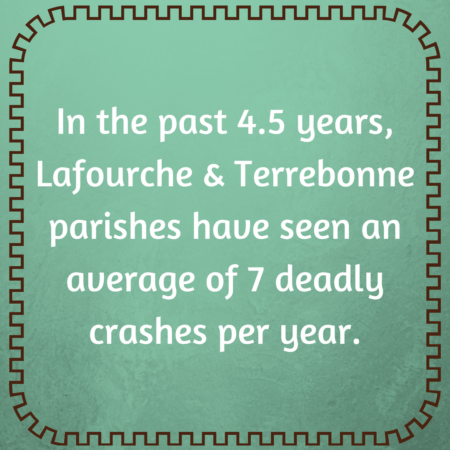
This unfortunate number is a bit difficult to break down by parish, but news articles in databug.com archives point to the majority of crashes occurring in Iberia, St. Charles, and St. Mary parishes.
CEO of Gray’s South Central Planning and Development Commission, Kevin Belanger, says lack of controlled access onto Highway 90 is the reason for so many deadly crashes.
He notes that there are access points all over US 90, with people entering the road from all of the points, and most of the collisions are due to sudden braking. Rear-end collisions and side collisions are common as people turn onto and enter the roadway.
Local politicians and businesses have pushed for years to get US 90 upgraded to current interstate standards. They’ve advocated for the revamped highway, which would be called I-49 South, to have limited access in order to ease travel between New Orleans and Lafayette.
CDM Smith and Regional Economic Models recently conducted a study for the Community Foundation of Acadiana that mostly focused on Lafayette; they projected upgrading the stretch of roadway from Raceland to Des Allemandes would cost about $150 million. This proposed highway upgrade is estimated to be completed by 2023. Additionally, a proposed upgrade to Interstate 310 in St. Charles Parish would cost $838.5 million and not be completed until 2021.
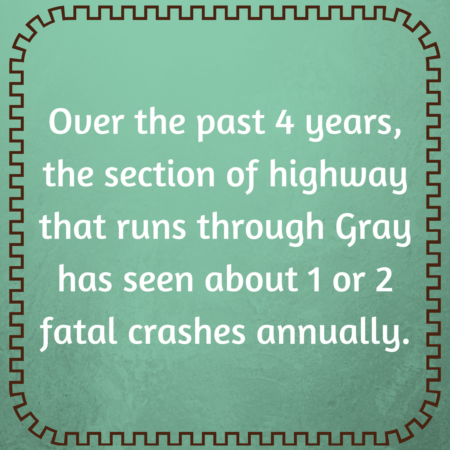
All of these proposals are considered rather optimistic since the United States federal government and the Louisiana state government are currently lacking in source money to complete such projects. Regarding US 90, State Police Troop C reports:
Until these sections of roadway are updated, drivers must be careful when entering the highway and while driving on it. Distracted driving must be quelled and all drivers must understand that their concentration on the road is required at all times. Any slip in attention while driving, especially on US 90, can lead to injury or fatality for a driver and others on the interstate.
If you’ve been a victim of a distracted driver or negligent driver accident in Louisiana, fill out the form on this page to contact the Law Offices of Tony Tramontana. We’d like to hear your story and let you know how we can help.
A recent study has identified US 90 running through South Louisiana as the most dangerous highway in the entire state, also reportedly the 13th most dangerous highway in the country.
A recent study has identified US 90 running through South Louisiana as the most dangerous highway in the entire state, also reportedly the 13th most dangerous highway in the country.
In the study, which business fleet and transportation consulting firm Geotab released to the public, data compiled by the Federal Highway Administration and National Highway Traffic Safety Administration was combed through to reveal the most dangerous highways. All highways considered were given a “Fatal Crash Rate” as determined by examining the number of deadly crashes occurring on the road while also adjusting numbers for daily traffic figures.
The Geotab study data shows that US 90 sees an average of 27 deadly crashes each year.
This unfortunate number is a bit difficult to break down by parish, but news articles in databug.com archives point to the majority of crashes occurring in Iberia, St. Charles, and St. Mary parishes.
CEO of Gray’s South Central Planning and Development Commission, Kevin Belanger, says lack of controlled access onto Highway 90 is the reason for so many deadly crashes.
He notes that there are access points all over US 90, with people entering the road from all of the points, and most of the collisions are due to sudden braking. Rear-end collisions and side collisions are common as people turn onto and enter the roadway.
Local politicians and businesses have pushed for years to get US 90 upgraded to current interstate standards. They’ve advocated for the revamped highway, which would be called I-49 South, to have limited access in order to ease travel between New Orleans and Lafayette.
CDM Smith and Regional Economic Models recently conducted a study for the Community Foundation of Acadiana that mostly focused on Lafayette; they projected upgrading the stretch of roadway from Raceland to Des Allemandes would cost about $150 million. This proposed highway upgrade is estimated to be completed by 2023. Additionally, a proposed upgrade to Interstate 310 in St. Charles Parish would cost $838.5 million and not be completed until 2021.
All of these proposals are considered rather optimistic since the United States federal government and the Louisiana state government are currently lacking in source money to complete such projects. Regarding US 90, State Police Troop C reports:
Until these sections of roadway are updated, drivers must be careful when entering the highway and while driving on it. Distracted driving must be quelled and all drivers must understand that their concentration on the road is required at all times. Any slip in attention while driving, especially on US 90, can lead to injury or fatality for a driver and others on the interstate.
If you’ve been a victim of a distracted driver or negligent driver accident in Louisiana, fill out the form on this page to contact the Law Offices of Tony Tramontana. We’d like to hear your story and let you know how we can help.
Louisiana certainly has its share of leisure and entertainment activities, and it is well-known for its live music and street festivals. However, a new study shows that people who live in the state are generally stressed out.
WalletHub recently ranked all U.S. states according to a stress survey it created, which compiled results and gave a score to each state based on factors focusing on 4 areas: work-related stress, money-related stress, family-related stress, and health and safety-related stress.
Alabama came in first with a stress score of 56.91. Louisiana came in second with a score of 56.22.
<iframe src="https://cdn.wallethub.com/wallethub/embed/32218/geochart-stressed-states.html" width="556" height="347" frameBorder="0" scrolling="no"></iframe><div style="width:556px;font-size:12px;color:#888;">Source: <a href="https://wallethub.com/edu/most-stressful-states/32218">WalletHub</a></div>Stress levels reached their lowest in an entire decade in 2016. But, there’s some disturbing news regarding today’s stress climate. This year, we’ve seen stress go back up and it encompasses many areas of life. While 10 years ago stress may have been mostly related to work and money, today it is mostly caused by anxiety over election results, our current social and political climate, fear of violence, and the future of our country.
So, what exactly are people in Louisiana stressed about? The WalletHub survey took 33 elements into account, including but not limited to:
Their data showed some concerning information about stressful situations among our state’s residents; however, they also offered some useful expert tips on how to reduce stress.
These tips are absolutely relevant to Louisiana citizens. Less stress in our lives can mean fewer accidents and injuries due to the distraction of stressful thoughts and feelings. Reducing stress is a positive path toward health on many levels.
Louisiana’s stress score of 56.22 on the WalletHub survey doesn’t bode well for our state’s residents. The following are some of the survey’s findings, which likely contributed to Louisiana’s high stress score.
The state of Louisiana ranked:
In contrast, the state of Minnesota came in on the WalletHub survey as the least stressed out state, with a score of 31.07.
Louisiana residents overall ranked family-related stress highest, followed by money-related stress, health- and safety-related stress, and finally work-related stress. The WalletHub findings showed that northern states generally have lower stress levels. Minnesota, North Dakota, and Iowa are the least stressed states, according to the survey.
Interestingly enough, the survey broke down data to rank states based on things like “Most Average Hours Worked per Week” and “Lowest Job Security,” and Louisiana did not rank in the top 5 for either of these classifications. Yet, stress is still rampant throughout the state, presumably for other reasons.
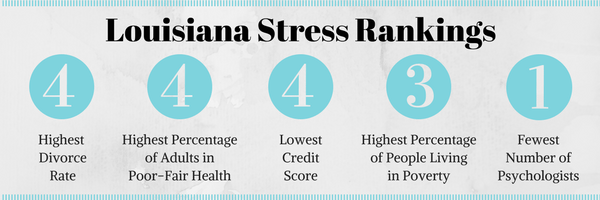
Experts say the best ways to cope with stress include doing simple things, such as connecting and spending time with an animal, playing with children, laughing, planning ahead, being disciplined with finances, avoiding over scheduling, and taking better care of oneself, physically and mentally.
Stress—prolonged and chronic stress in particular—is a lot for the body and mind to manage. It can lead to careless, reckless, and thoughtless behavior that may harm oneself and others by causing car accidents, mistakes and injuries on the job, and abuse.
Most of us could probably use a lesson in how to better manage stress. Some people, unfortunately, haven’t figured out how to do this very well, and they’ve caused injuries as a result. If you’ve been a victim of personal injury of any kind, stress-related or otherwise, contact the law office of Tony Tramontana for a free consultation today.
Even though fatal car crashes in the United States have decreased in number, traffic collisions remain a grave problem. It’s a promising sign that there were approximately 10,000 fewer accidents in 2014 than in 2004, but 32,675 people were still killed in auto accidents.
Even though fatal car crashes in the United States have decreased in number, traffic collisions remain a grave problem. It’s a promising sign that there were approximately 10,000 fewer accidents in 2014 than in 2004, but 32,675 people were still killed in auto accidents.

Louisiana, unfortunately, did not escape the list of top 10 most dangerous states to drive in for 2014. However, it’s our hope that the community as a whole will work to improve these numbers and our dangerous road situations in the coming years, reducing unnecessary vehicle deaths. The following are the top 10, starting with the least dangerous: Louisiana.
Louisiana saw 15.9 road deaths per 100,000 people. It had 737 total roadway fatalities, and 51% of all fatal crashes occurred on rural roads.
In South Dakota, 15.9 people per 100,000 died in auto accidents on the road. In 2014, this state had 136 total roadway fatalities, and 85% of fatal crashes occurred on rural roads.
Alabama had 16.9 road deaths per 100,000 citizens and 820 total roadway fatalities. The state saw 66% of fatal crashes occur on rural roads.
Coming in 7th on the most dangerous states to drive in list, South Carolina had 17.1 road deaths per 100,000 people. The total roadway fatalities for 2014 came in at 824, but 90% of individuals in the state were wearing seatbelts.
Oklahoma experienced 17.3 road deaths per 100,000 people in 2014, and it had 669 total roadway fatalities. An unfortunate 90% of the drivers killed had a blood alcohol content (BAC) of equal or greater than 0.08.
North Dakota saw 18.3 road deaths per 100,000 people. But, it had the 4th highest percentage of fatal crashes on rural roads. 33% of drivers killed on roads in this state had a BAC of equal or greater than 0.08.
In New Mexico, 18.4 road deaths occurred for every 100.000 people. 92% of residents use seat belts in New Mexico, and 64% of fatal crashes occur on rural roads.
Montana’s residents aren’t wearing seatbelts like they should. Only 74% of people buckle up while driving, and 18.8 road deaths occurred per 100,000 people.
Mississippi had the 7th lowest number of citizens wearing seatbelts, coming in at just 78%. For every 100,000 people in the state, there were 20.3 deaths. In Mississippi, 91% of fatal auto crashes occurred on rural roads.
Wyoming is the worst state on the top 10 most dangerous roads list. There, 150 fatalities happened on roadways, a high 25.7 fatalities for every 100,000 residents.
There’s a trend with the states listed above. All of them have high numbers of fatalities occurring on rural roads. In general, these types of highways and streets are less safe than those in highly populated areas. Looking specifically at dangerous roads in Louisiana, we have several of concern:
All of these interstate roads have ranked in a list of the deadliest highways in the U.S.
We want Louisiana residents to stay safe on our roads and stay off statistics lists. While it may take some time to make that happen, choosing not to drive distracted or while under the influence is a good start, as is wearing a seat belt every time you’re in a motor vehicle.
If you’ve been the victim of the actions of someone who wasn’t driving safe, Tony Tramontana Attorney at Law wants to help. Fill out the contact form on this page to get information on how to handle a personal injury situation involving a car accident.
Riding a bike, especially on public roadways, is about more than learning to balance on two wheels: it’s something that drivers, as well as cyclists, must take seriously or risk injury or even death. To stay safe on shared roadways in Louisiana, cyclists should become fluent in the state’s bicycle laws to minimize risk to themselves, as well as others on the road.
Here’s an overview of Louisiana’s current bicycle laws, and important legal information, in the event that you are ever injured while riding a bike in Louisiana.
Cyclists over the age of 12 are not legally allowed to ride on sidewalks in Louisiana. Bike lanes are for the exclusive use of cyclists; you’ll often see them to the rightmost side of the roadway, and save a few exceptions, drivers are not permitted to enter these lanes.
Bicycles, cars, and trucks have to share the road. In fact, in Louisiana, bicycles are considered by law to be vehicles according to the statute that defines vehicles. this means that a person riding a bicycle has all of the same rights and duties of the driver of a motor vehicle under Louisiana law. According to state statute, every person operating a bicycle on a public roadway must ride as close to the right of the roadway as possible, whether there’s a bike lane or not. However, cyclists are free to leave the bike lane for all the following reasons:
Similarly, motor vehicles may enter or pass through a bike lane in the following instances:
Note that motor vehicles MUST ALWAYS yield to cyclists, as well as electric mobility aids within the bike lane.
Moreover, in the state of Louisiana, a minimum of three feet must be maintained if a motor vehicle wishes to pass a cyclist going in the same direction. This is true whether the cyclist is in a designated bike lane or not.
Louisiana law requires a bicycle operator or passenger that is under the age of 12 years old to wear a bike helmet while riding a bike. The law also requires any passengers less than forty pounds, or less then 40 inches tall, to be secured in a retraining seat.
Just like motor vehicles, traffic signals are an important part of road safety. Cyclists are required to signal in the following ways:
These hand singles are not required if the safety of the cyclists requires both hands to control the bike.
Even if everyone practices caution while sharing the road with cyclists, bicycle accidents still happen in Louisiana. Bicyclists face much higher risk of injury and death due to hazards on the road. If you have questions about a bicycle accident or personal injury caused while you were on a bike in northeastern Louisiana, we at the Monroe Law Office of J. Antonio Tramontana want to hear from you.
For a free case review, please fill out the form to the right, or call me directly at (888) 982-1290.